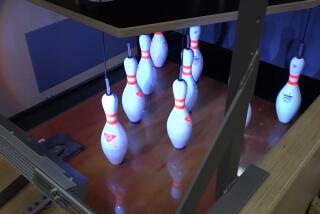Bowled Over by the New Perfection
- Share via
There was a time when bowling a 300 game was the sporting equivalent of scoring 1600 on the SATs.
It was perfection, an earthly manifestation of the ideal, an opportunity to swagger, to show off your gold ring from the American Bowling Congress, to know that at least one paragraph in your obituary would speak to something besides your standing as a loyal employee and a good family man.
But now, no sooner do I quit bowling for a few decades, than they’ve gone and changed the standards on me. This is what people in government like to call a paradigm shift, even though some of our elected officials tend to pronounce the silent G.
The 300 game still is a big deal.
But it’s not what it was.
For technology--the fickle goddess that drained the taste from our tomatoes, the fat from our beef, and the lead from our gasoline--also has sapped some of the glory from the perfect game. In 1968-69, the American Bowling Congress logged 905 perfect games across the U.S. Last year, the number was 34,470, more than 94 each day.
In Ventura County, there were fewer than one a year from the founding of the local bowling association in 1953 until the early 1980s. Last year, there were 88 at Harley’s Simi Bowl alone, more than anyplace else in Southern California.
It’s as though everyone in coach suddenly jammed into the first-class cabin, swigging champagne and unfolding complimentary copies of the Wall Street Journal. It’s as though sainthood were accessible not only to martyrs, but to people who are just pretty good.
At Simi Valley Bowl, owner Ron Plander had to find a polished wooden board big enough for the Band-Aid-sized brass plaques honoring bowlers who have shot perfect games and other high scores. It now bears some 400 plaques, including four for perfect games shot just last Sept. 29.
“It’s still exciting,” Plander said. “Usually most people stop bowling, and there’s applause and stuff. But it’s not as much as it was 10 years ago.”
So just what is going on in our bowling centers? (I’d call them “bowling alleys,” but the industry hates to see that outdated term in print.)
At Buena Lanes in Ventura, Dan Mueller laments the passing of an era. A generation ago, balls were made of hard rubber. Now they’re made of something called “proactive resin”--the latest in a series of high-tech materials promising bowlers more spin, more revolutions, more power, a killer hook, a more effective “coefficient of friction” and more strikes.
Pins are easier to knock down now and lane surfaces are smoother, Mueller said. And the American Bowling Congress allows proprietors to oil lanes in patterns that can guide a well-thrown, well-placed ball to Strike City.
“I’m bowling better now than I was 10 years ago, when I was a better bowler,” Mueller said. “It’s excellent for recreational bowling, but it’s not good for the sport.”
Hence . . . A Zen riddle: When is perfection less than perfect?
The answer will come only with proper attitude, a pair of rented shoes and a cold beer.
The American Bowling Congress is talking about developing tougher standards for serious bowlers. Many lanes could still be gussied up with strike-inducing oil patterns, but others would be for bowlers seeking a challenge beyond mere perfection.
In the meantime, John Richardson, a Santa Paula rancher who heads the Ventura County Bowling Assn., summed up the situation perfectly: “You still have to knock the pins down,” he said.
*
Steve Chawkins can be reached at 653-7561 or at [email protected].
More to Read
Go beyond the scoreboard
Get the latest on L.A.'s teams in the daily Sports Report newsletter.
You may occasionally receive promotional content from the Los Angeles Times.











